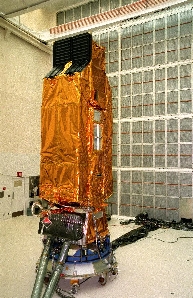

National Aeronautics and Space Administration
John F. Kennedy Space Center
Kennedy Space Center, Florida 32899
407/867-7819
FOR RELEASE: April 5, 1999
PHOTO NO.: KSC-99PP-0382
No copyright protection is asserted for this photography.
If a recognizable person appears in this photograph, use for commercial purposes may infringe a right of privacy or publicity.
It may not be used to state or imply the endorsement by NASA employees of a commercial product, process or service, or used in any other manner that might mislead. Accordingly, it is requested that if this photograph is used in advertising and other commercial promotion, layout and copy be submitted to NASA prior to release.
PHOTO CREDIT: NASA or National Aeronautics and Space Administration
KENNEDY SPACE CENTER, FLA. -- At Hangar AE, Cape Canaveral Air Station, NASA's Far Ultraviolet Spectroscopic Explorer (FUSE) satellite stands alone after workstands have been removed. As part of prelaunch processing, FUSE will undergo a functional test of its systems, followed by installation of the flight batteries and solar arrays. Tests are also scheduled for the communications and data systems linking FUSE with the spacecraft control center at The Johns Hopkins University, Baltimore, Md. FUSE was developed and will be operated by The Johns Hopkins University under contract to Goddard Space Flight Center, Greenbelt, Md. FUSE will investigate the origin and evolution of the lightest elements in the universe - hydrogen and deuterium. In addition, the FUSE satellite will examine the forces and process involved in the evolution of the galaxies, stars and planetary systems by investigating light in the far ultraviolet portion of the electromagnetic spectrum. The launch aboard a Boeing Delta II rocket is targeted for May 20 at Launch Complex 17.
